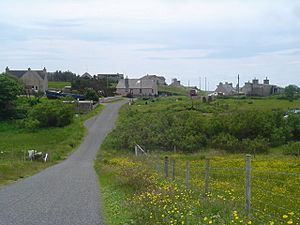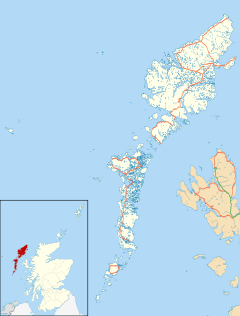Coll, Lewis facts for kids
Quick facts for kids Coll
|
|
|---|---|
 The single track road which winds through the villages of Inner Coll and Vatisker |
|
| Language | Scottish Gaelic English |
| OS grid reference | NB465400 |
| Civil parish | |
| Council area | |
| Lieutenancy area | |
| Country | Scotland |
| Sovereign state | United Kingdom |
| Post town | ISLE OF LEWIS |
| Postcode district | HS2 |
| Dialling code | 01851 |
| Police | Northern |
| Fire | Highlands and Islands |
| Ambulance | Scottish |
| EU Parliament | Scotland |
| UK Parliament |
|
| Scottish Parliament |
|
Coll (which is Col in Scottish Gaelic) is a small farming village. It is located near Stornoway on the Isle of Lewis. This island is part of the Outer Hebrides in Scotland. Coll is found along the B895 road. It lies between Stornoway and New Tolsta. It is also part of the Stornoway area.
Contents
History of Land and People
From 1888 to 1921, Coll and nearby farms like Tong and Gress were important. They were the scene of several "land raids." These events were part of a bigger struggle. It was a conflict between the people of Lewis, the landowners, and the government.
Life on Lewis in the 1800s
During the 1800s, many rural parts of Scotland, including Lewis, became very poor. Many people left or were forced to leave their homes. This was due to the Highland Clearances. Landowners made tenant farmers move off their land. Life was hard, and there was sometimes not enough food. Many people moved away hoping for a better life.
Around the early 1900s, the British government tried to help. They wanted to provide land for small farms or crofts. A croft is a small piece of land used for farming. They also wanted to improve how land was rented. After World War I, there was a promise. Soldiers returning from the war were told they would get land. They would have "a land fit for heroes to live in."
Landowners and Their Plans
This idea of giving land to people was not popular with Scottish landowners. They often tried to stop it. The Isle of Lewis was different because it was owned by rich business people. From 1844, the Matheson family owned it. Then, in 1917, William Hesketh Lever, Lord Leverhulme, bought the island. He was a very rich soap maker.
These owners had big plans for the island. They wanted to build industries like fishing and tweed making. They did not want to give land for small farms. They thought this was an old-fashioned way of life. But the people of Lewis had no land. They lived in crowded, poor conditions. Meanwhile, good farmland was used for sheep, deer hunting, or grouse shooting.
The Land Raids Begin
In the 1880s, people in Ireland started to demand land reform. This movement soon spread to Scotland. People refused to pay rent. They sometimes damaged farm property or took over land. There were conflicts in places like Skye and Uist. In January 1888, part of the Coll farm was taken over in a land raid. This first wave of protests slowed down when the economy improved. People also hoped the government would act.
The government did pass laws to help. But giving out land was very slow. It became even slower when World War I started in 1914. After the war, there was strong support for returning soldiers. People expected the government to keep its promise. When nothing happened, people became angry. Land raids started again.
Lord Leverhulme and the Raids on Lewis
On Lewis, Lord Leverhulme had big plans for the island. He invested a lot of money and created jobs. At first, people liked him. But in March 1919, his opposition to land settlements became known. Soon after, the farms of Tong, Coll, and Gress were raided. People took over the land.
By autumn, the raiders were convinced to leave. But in January 1920, they raided Coll and Gress again. This time, they started building houses there. Lord Leverhulme reacted by stopping all his development work. He stopped it first in that area, then across all of Lewis. This caused a huge uproar.
Lord Leverhulme argued that Coll and Gress were needed as dairy farms. They supplied milk to Stornoway. He said he would restart his projects if the raiders left. He offered land on the west coast of the island as a compromise. He also got the government to agree. They would not force him to give up land for ten years. This was if his development work continued. So, in autumn 1920, the raiders were again persuaded to leave.
The Final Resolution
Some farms on the west coast of Lewis were indeed settled. This happened just in time to prevent more land raids there. But in spring 1921, Coll and Gress were raided once more. Lord Leverhulme again stopped his developments. The government then felt free to use its powers.
Faced with this strong official action, Lord Leverhulme gave in. He agreed to the settlement of the entire farms of Coll and Gress. He also agreed to part of Orinsay in the south of Lewis. He did this rather than lose them slowly through legal battles.
Conflicts continued on Lewis, especially around the farm of Galson. But by this time, Lord Leverhulme was giving up on his plans for Lewis. He started to focus on Harris, the island next door. He was also having money problems. In 1925, he died. His many projects on Harris and Lewis ended suddenly.


